Art & Design Degrees: What is Art Design, and What Can I Do with a Degree in Art and Design?
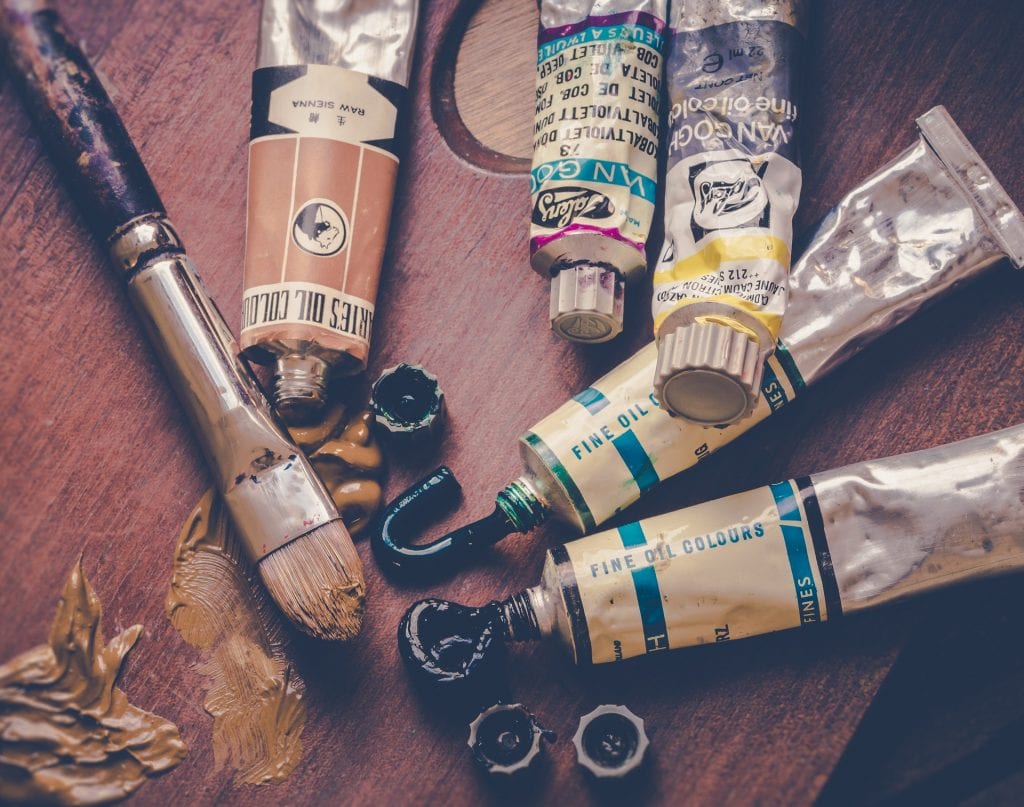
Find your perfect value college
Thinking of going into the arts? Don’t tell your parents right away. Everyone knows artists are starving, with 4 roommates, three part-time jobs and nothing to show but massive student loan bills, right?
Not necessarily true.
Featured Programs
Those following their muse to a major like Art or Design may not graduate to a six-figure job like their peers in the popular STEM fields. However, graduates can land lucrative creative positions in a variety of places such as:
- design companies
- production houses
- fancy restaurants
- prestigious teaching positions in higher education.
Many corporations seek highly creative individuals to execute visually compelling websites for their product or service needs.
[Check out our NEW Art & Design related rankings – Top 20 Best Packaging Programs and Top Bachelors in Industrial Design Programs]Before pursuing degrees in art and design, you should know there is a key difference between art and design. Design is created to serve a purpose and usually has a more commercial connotation. Art is meant to provoke emotions. Art may be created and sold, but it isn’t made to solve a problem. However, this does not mean the design is not art. Design projects can serve a purpose and bring out an emotional response. Many designers consider themselves artists and vice versa.
This is the reason many art students pursue multiple disciplines in the field. Design students are usually required complete classes in the fine arts, such as art history and drawing. When students choose a specialization in the art department, they may have an interest in more than one area. As an example, an undergraduate fine arts student may end up earning his or her master’s degree in design.
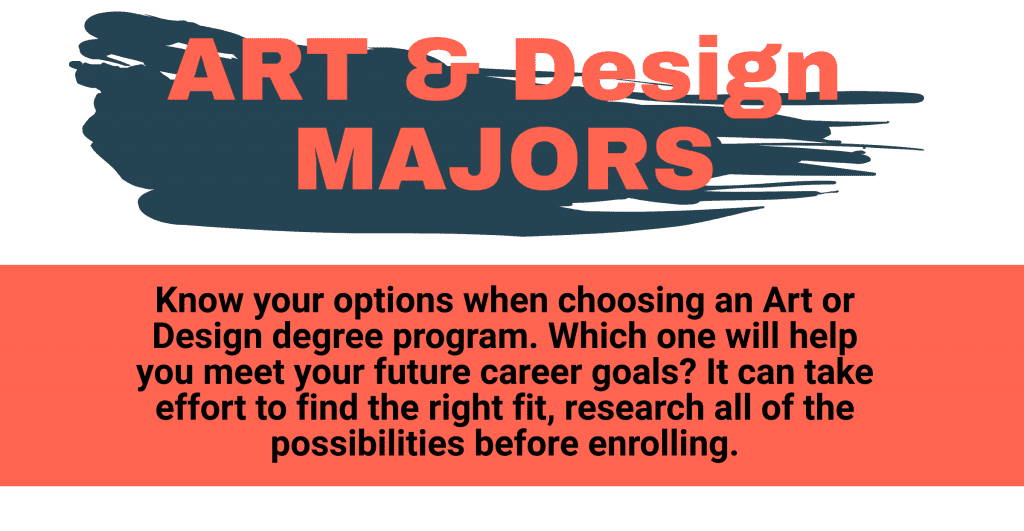
When choosing an art degree program, these are common questions students will ask themselves:
What is Art and Design?
So exactly what is arts and design? Trying to define the field of art and design is challenging. Art and design is a broad concept and many individuals believe it refers to projects created through:
- painting
- sculpting
- drawing
Both art and design use media. Fine art may use traditional media like:
- oil paints
- marble
- bronze
- colored pencils
- crayons
These tools are used on canvas, paper, and wood to create works of art. Non-conventional modern art projects may use less traditional mediums such as:
- seeds
- trash
- bottle tops
- food.
Graphic design mediums are typically different with typography, photos, and illustrations used together to send a message. Graphic design projects may appear on:
- t-shirts
- billboards
- pamphlets
- business cards
- websites
Creativity is needed for graphic design creations, but the end goal is to generate sales for the client.
The relationship between art and design is relatively simple. An artist must design a project prior to creation. An artistic design definition usually refers to the pre-planning stage of a project. This may include preliminary sketches made before work commences for the final project. Even designers need to rely on sketches. They’re part of the artistic process to develop and perfect idea
It’s important to note that the definition of design by different authors will contrast wildly. Art is a highly subjective field. One of the draws of the industry is that interpretations of what is design and what is art can be often left up to the individual.
How to Decide Between Graphic Design vs Art Degrees?
Both graphic design and art are creative fields. A key similarity between art and design is that the person will create visual interpretations and have an objective in mind before starting a project. A studio artist will feel inspired and may plot out his or her next project in the mind or on paper. Additionally, a studio artist may be hired to brainstorm a project with a client who orders a commission. Although the artist will still need to interpret the idea onto canvas or paper, the art buyer will provide the guidelines for the project. Artistic commissions may be done through private buyers or arranged through galleries.
A graphic design career will be very different than a career as an artist. Graphic designers can work independently or for a larger company. They will be responsible for delivering a client’s message in a meaningful and creative way. They work less independently than someone in fine art. They typically need to answer to or collaborate with several team members. Graphic design relies on technology often. Professionals use software programs to design:
- brochures
- logos
- posters
- advertisements
- web pages
Art majors don’t necessarily have to rely on their artistic endeavors for an income. An artist could secure a position as an educator or work as a critic for a publication. Museums may also hire an art degree holder to curate works for display. Art and design majors could also go into education and teach school-age children or college-level classes.
School and Program Accreditation
Accreditation is always an important factor when deciding on the right art degree program. However, accreditation is especially important for art degrees online. Enrolling as a fine arts major at an online school that does not have national or regional accreditation is problematic. To start, an employer may not accept the degree if the school lacks accreditation. In the past, individuals have attempted to pass off paid degrees as being real degrees. Because of this, many employers confirm the validity of a degree before hiring an individual. Moreover, when students transfer to another university, the credits they previously earned must come from an accredited online fine art school.
If the school was not accredited, two years or more of classwork could no longer be used toward a degree.
Lastly, accreditation is required for the eligibility of many federal and state loan and grant programs. Without it, the student will be responsible for paying for college without government assistance. The U.S. Department of Education chooses the accrediting organizations that they permit to evaluate higher education facilities. An entity advertised as an “online art school free” is not likely to have the proper accreditation and should be a red flag.
To receive accreditation, the college must abide by the strict guidelines of the accrediting institution. The college must prove that its programs are preparing students for jobs in the arts and design industry. High standards must be maintained since arts colleges and their media arts degrees will be periodically re-evaluated.

For all majors, regional accreditation is preferred over national accreditation. The reason it is better to choose a regionally accredited institution is that more colleges accept transfer credits from this type. The location of the traditional or online fine art school determines the correct regional accrediting agency.
As an example, art major colleges in California will be accredited through the Western Association of Schools and Colleges. Colleges located in the Carolinas would need to have earned regional accreditation through the Southern Association of Colleges and Schools. National accreditation is typically not associated with fine arts degrees.
National accreditation usually applies exclusively to vocational or career schools. Two notable exceptions for art students include:
- the National Association of Schools of Art and Design
- the Council for Interior Design Accreditation
Review the guidelines of these accrediting agencies before deciding whether the college degree program meets industry standards.
Degree Program Types
There are many types of art degrees available today both undergraduate and graduate degrees.
AA/AFA: This is entry-level. A community college is a good place to earn an Associate of Art (0r Fine Art) degree. You can also earn certain specialized 2-year vocational schools such as:
- cooking schools
- film/animation schools
- hair design academies
- music conservatories
Those who obtain their degrees from community colleges may have more opportunities to transfer to 4-year institutions for advanced degrees.
[Check out: What is the Benefit of Going to a Community College?]BA/BFA: A Bachelor’s degree is 4 years of study. In creative fields that will prepare students to work at a professional level in most entry-level capacities. BAs and BFAs are offered in a variety of majors such as:
- Web/Graphic Design
- Industrial Design
- Video/Media/Digital Production
- Fashion Design
- Marketing
- Music/Entertainment
- the Visual Arts.
Beyond visual art, music is also usually a BFA.
MA/MFA: At the Master’s level, the student is most likely intending to teach their expertise at the College-level. Some Creative Therapy majors (Art and Music) require this terminal degree in addition to Psychology to become practicing Licensed Therapists.
PhD: A doctoral degree is a rare find for Art or Design. The MA/MFA is usually the terminal degree. Again, for those in Creative therapies, this may be offered at particular institutions, though often not a necessary education path.
Types of Arts Degrees
Arts and design major options are abundant. There are many different majors in art and design – as many as there are artistic fields. Students can choose to pursue art and design degrees at the associate, bachelor, master, and doctoral levels. Many types of art courses are found at traditional colleges. The number of art degrees online currently available is growing. Online art education allows different art majors to meet work and family obligations and take classes on a part-time basis. An online fine art school will require virtual interaction between students and professors. Besides viewing instructional videos, the student may have to upload images of their art projects. Occasional campus visits could be another requirement for degree conferment.
Admissions to art majors will usually depend on the program requirements. Traditional admissions rules may not apply to fine arts majors. Instead of looking at standardized test scores and GPA numbers, the art department may want the student to submit a portfolio for review. However, design degrees and visual arts degrees may have standard criteria for admission. Students will likely need a minimum GPA and SAT score to gain entry to a bachelor’s degree arts program. Associate-level art degree programs usually have limited entry requirements and will only ask for students to have a high school diploma or equivalent.
Master’s level and higher degree programs require a bachelor’s degree in an art-related major. Graduate-level coursework is usually more focused than undergraduate classes. For instance, design students learn basic concepts in a bachelor’s degree program. They study more about sustainability and ethics of design in a master’s degree program. Doctoral arts degrees are limited, but some options are available to those looking to enter the education field. PhD programs in the arts prepare graduates for positions as:
- professors
- deans
- department chairs
- museum directors
PhD programs require about two years of doctoral credits and a dissertation.
Best Value Residential Rankings
Top 50 Best Value Bachelor’s of Industrial Design
Top 20 Best Value Packaging Degree Programs
Top 50 Best Value Undergraduate Schools
Top 50 Best Value Graduate Schools
Top 25 Online Interior Design Programs
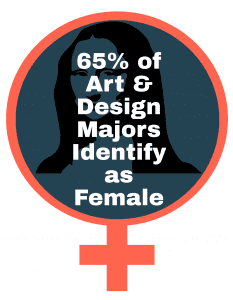
Design and arts majors that a student may choose from include:
Game and interactive media design: When choosing a game and interactive media design major, you will be learning advanced computer programming and animation techniques. Storyboarding is another part of the major since you’re meant to create a story in all interactive video games. This design degree can usually be earned online within two to four years.
Digital arts: Digital art majors are preparing themselves for careers in a variety of industries. In a digital art degree program, the you learn about different aspects of:
- web design
- video production
- interactive media design
- 3D modeling.
Digital art degrees can usually be earned in four years or less.
Graphic design: Graphic design majors learn to use various mediums to create projects for clients. They must learn to craft clear visual messages with their designs. Coursework in the major may include:
- desktop publishing
- computer art
- interactive media
- digital imaging
Graphic design majors are typically geared toward undergraduates. However, a growing number of online colleges are offering further studies with master’s level courses.
Photography: Photography degrees are most often pursued at technical and community colleges as an associate degree. However, photography and photojournalism degrees can be earned from four-year universities.
Fine arts: Fine art degrees are also often called studio art degrees. Fine art majors can choose anywhere from a two-year plan of study to a six-year master degree. Most fine arts students enrolled in master’s programs will choose traditional colleges over art online schools because they aim to spend more time in the studio.
Interior design: Interior design programs range from an associate degree to a doctoral program. Topics covered in interior design classes are:
- design concepts
- computer design programs
- sustainable design
Art history: Art history majors are perfect for those looking to educate others about historical and modern pieces of art. Art history degrees are available to undergraduates. However, if you’re looking to pursue a position as an educator, you’ll need to pursue a master’s degree or higher. Since fewer in-person interactions are required for art history majors, online art schools will frequently have this as a degree option.
Industrial and product design: Industrial and product design majors are intended for those who wish to conceptualize new products. Graduates of an industrial design major will know:
- how to design a new product
- the manufacturing process for products
- how to package products
You’ll work with raw materials in industrial design, 3D and computer design technologies.
UX/UI design: UX/UI design degrees can usually be earned through a certification program or associate level program. UX/UI design can also be found as a course offering for graphic design majors. UX/UI courses teach designers how to create projects that are optimized to improve user experience. UX/UI design classes are a top choice for students enrolled in online visual arts colleges.
Textiles: A textiles degree is usually an option if you’re looking for a position in the fashion industry. In a textiles degree program, students learn how to work with different materials and fabrics to create designs. Fashion design degrees also teach about the manufacturing and marketing of clothing pieces.
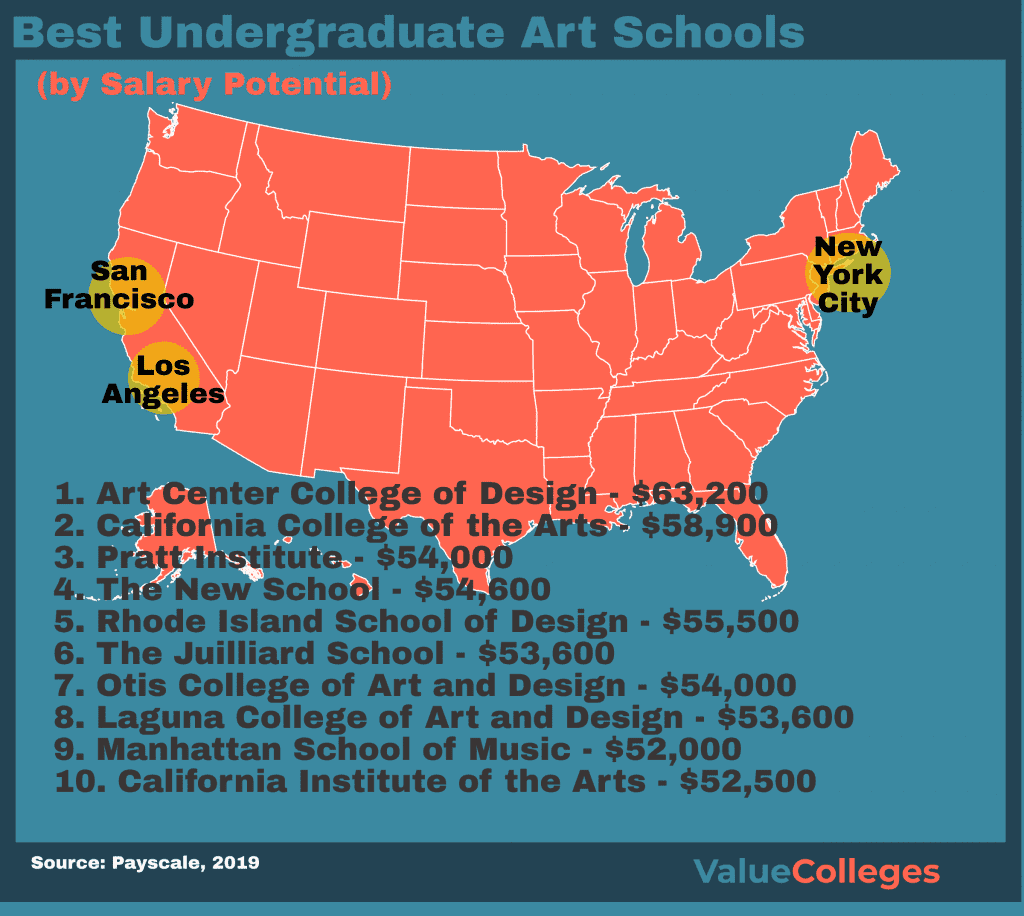
Are Dual Degrees Possible Within the Arts?
Arts degree seekers have numerous major options available. You may choose to take on a double major and receive a degree in both visual arts and graphic design. In the curriculum for both art and design, you will likely have to take classes that cover both topics. Additionally, you may earn an undergraduate degree in fine arts before pursuing a master’s degree in design.
Most students choose a specialization in art after taking different undergraduate courses and finding a specific type of work that inspires them. For instance, an art major may take a photography course and choose to pursue a career as a nature or portrait photographer. After graduation, photography courses can be taken at a four-year university or technical college. Additionally, many artists will have more than one job. For instance, a painter may work as an art lecturer between commissions. He or she could also be hired to write articles for an art publication and provide an expert view on works.
Whether you choose a design degree or a visual arts degree, both career paths can be lucrative and satisfying. The majority of art and design jobs require a minimum of a bachelor degree.
Online vs. Residential Programs
After choosing a major, you need to decide on whether you would like to go the traditional route of attending a residential program or virtually through an online program. Depending on the major, there may be valid benefits to attending class in person.
[check out: Are Online Degrees a Good Investment?]Online programs can be very useful for the working adult returning to school for a second career or promotion. Prerequisites in almost all of the creative majors can be completed from online institutions. Almost all 4-year degrees require a core of standard liberal arts credits:
- English
- College Math
- Humanities
- Science
- Languages
Online study can be completed in a flexible manner while continuing to work or taking care of family responsibilities.
Best Value Online Rankings
Top 50 Alternative UX Design Programs
Top 50 Best Value Online Schools
Financing Education
A college education is rarely free, but it can be more affordable, the more you plan. If you have a 529 savings account, now is the time to access it. The first plan of attack is to fill out an annual FAFSA. Be careful to dot your i’s and cross your t’s – it is easy to make mistakes while filling out FAFSA. After you figure out your expected family contribution (EFC), you need to come up with the rest of the funds. The Federal Work Study program offers part-time work at your home campus and pays students a wage that can be used toward your remaining student tuition balance. Working on-campus is a great option for younger students with no prior work experience. You gain work experience. The job will also most likely be flexible with scheduling your hours around classes.
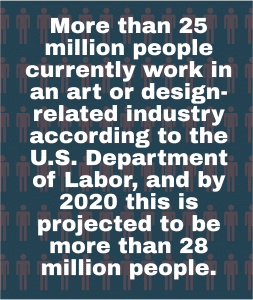
Student Loans should be your last option. Yes, they are often necessary, but we urge students to seek out federally subsidized loans rather than federal unsubsidized or, worse, private loans.
Furthermore, Federal Loans are a better choice than private loans. However, do remember that they will still have the potential to capitalize yearly if interest is not paid annually after the grace period. They will increase based on the interest rate secured at the date of borrowing just like private loans. The Federal Student Loan program does have better repayment options and hardship options if you need assistance.
Cheapest Rankings
Top 10 Cheapest Online Master’s Degree Programs
Careers With an Art and Design Degree
Careers in art and design are always evolving. With new technologies, more career paths are available to students, especially art design jobs. Instead of art students pursuing careers as sculptors and painters, more students are finding positions as video game designers and UX designers.
List of careers in art and design:
- Architect
- Art critics and authors
- Art directors
- Art educators
- Fashion designers
- Fashion manufacturers
- Graphic design careers
- Illustrators
- Industrial designers
- Interior design careers
- Jewelry makers
- Lecturers
- Museum curators
- Painters
- Photographers
- Printmakers
- Product developers
- Sculptors
- UX Designers
- Video game makers
- Web designers
Design careers in demand include:
- graphic designer
- video game designer
- web page designer
Graphic design careers require a mix of creativity and technical prowess. In the past decade, graphic design has become one of the top majors chosen by all higher education students. Graphic designer jobs also leave room for advancement with many top designers being promoted to art director positions. Over the last 10 years, sales figures for games and interactive media have exploded. Why? More individuals spend increasingly longer periods of time online. Game designer jobs will require the ability to work with design components such as:
- sound
- graphics
- animations
Art careers can also combine multiple disciplines. Graduates of art degree programs can find art careers in the medical field like a medical illustrator. In this career, you would be responsible for creating medically accurate drawings and animations. Careers related to design and engineering include an industrial designer and a design engineer.
Industrial designers develop concepts for products that will be manufactured.
Design engineers implement new products and systems and review current types for improvement purposes.
It is not uncommon to find graduates of double major programs. You may have earned a degree in a creative field like the arts and a scientific field like computer science. That is particularly true in a more technical field like industrial design. The goal is to show employers that you have both hard and soft skills.
Keep in mind that there are jobs for artists without degrees. Self-taught fine artists can independently sell their artwork to galleries and private buyers. Furthermore, not all art degree holders end up working in their fields of study. For instance, fine arts majors may eventually pursue careers as educators or museum curators. Studio art majors may end up hired to work for law enforcement as sketch artists. Careers in the arts and design fields will all involve some form of creative work. Artists can rely on their creativity to earn a substantial income throughout their careers.
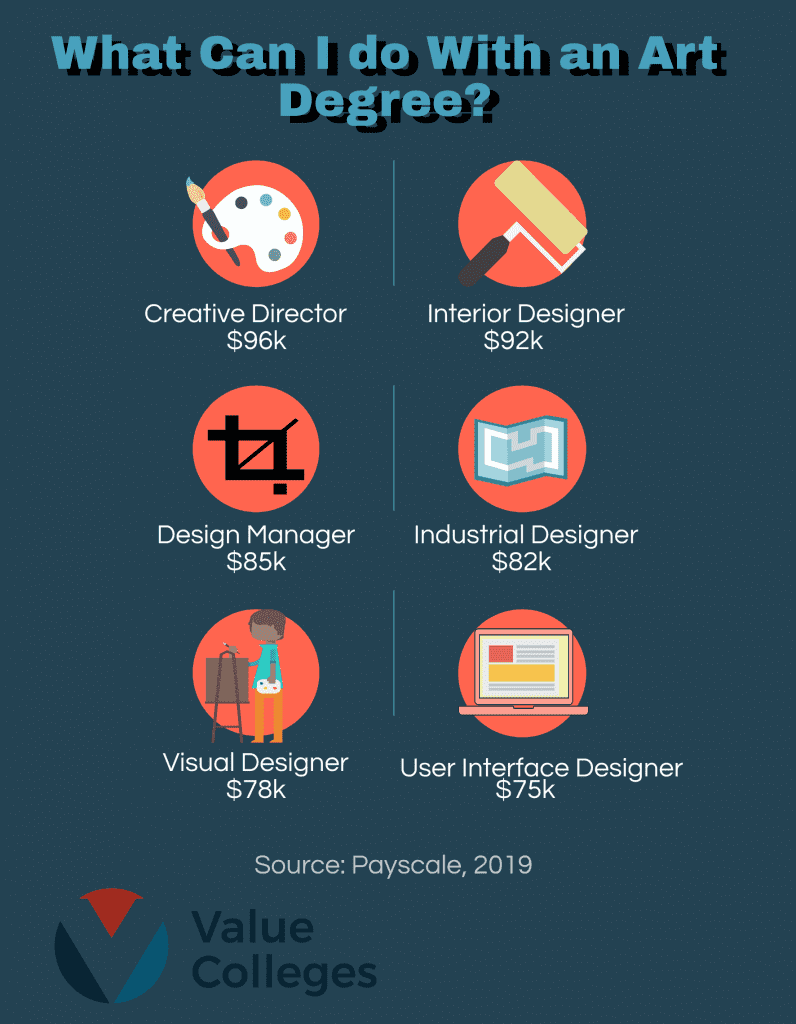
Salary Potential for Arts and Design
According to the Bureau of Labor Statistics, a bachelor’s degree in an Art and Design field can lead to an annual income of anywhere between $45,000 to $81,000. There seems to be more money made if a computer is involved in the career path. This isn’t surprising. Some of the fastest-growing design careers are Game and Software development, UI/UX web design, and Mobile App design. These careers are hard to report salaries on since they are relatively new and lacking in data. For example, some statistics show User Designers making a median of $72,000 annually. Others report around $90,000. Keep in mind, often in tech fields, salaries depend on where you choose to live regionally.
Although most people mistakenly relate artists to a poor living, art jobs that pay over 100k are readily available. Design salary figures are particularly impressive with a high projected growth rate for the next five to 10 years. Plus, the availability of jobs in the design industry is expected to grow by as much as 10 percent through 2028.
Craft and fine artists have a lower median salary due to the large disparity within the industry. Artists may make millions of dollars off commissions while others may only sell a painting or two annually. According to the Bureau of Labor Statistics, the average artist salary is $48,960 per year. The lowest earners in the industry can make just over $22,000 per year. However, the top earners have art jobs that pay over 100k salaries.
A graphic designer may only have a slightly higher average pay rate of $50,000 per year, but larger salaries are available for those who work in a specialized area of the industry. Geography also has a dramatic effect on graphic design salaries. With so many companies located in large cities, California and New York offer the highest average pay grades for the graphic designer. A graphic designer in these areas has an average median salary of $62,000 to $65,000.
Game designers and animators earn a salary that exceeds $72,000 per year. An added bonus for these positions is the potential for extra compensation. Designers and animators of games and media with high sales figures will often be awarded bonuses for their work.
Art directors are among the top earners for design degree holders. They are in charge of the overall style of print, TV, and movie productions. Successful graphic designers are often considered for open art director positions. An average art director’s salary is $92,780 per year with the highest earners in the field bringing in a salary of more than $172,000 annually.
Entry-level interior designers can make an average of $50,000 per year, but the potential for higher earnings is there. Interior design salaries can also exceed $100,000 per year. Interior designers work for high-income clients who want to create beautiful and functional spaces in their homes and businesses.
Art professors are another top-paying career in the field of arts and design. Post-secondary professors teach courses to undergraduate and graduate art and design students. The average salary of a full-time art professor is $78,470 per year.
One of the most lucrative design jobs is UX designer. Managers are in desperate need of qualified individuals with a background in UX design. In the field of UX design, the professional will research consumer needs and develop an optimized user experience for them. The average UX designer salary exceeds $100,000 per year.



Related Rankings:
- Top 25 Best Value Online Colleges
- Top 25 Lowest Out-of-State Tuition Colleges
- Top 50 Best Value Community Colleges
- Top 50 Best Value Online Graduate Schools
- Essential Guide to Online education in the USA
Featured Programs
Aya Andrews
Editor-in-Chief
Aya Andrews is a passionate educator and mother of two, with a diverse background that has shaped her approach to teaching and learning. Born in Metro Manila, she now calls San Diego home and is proud to be a Filipino-American. Aya earned her Masters degree in Education from San Diego State University, where she focused on developing innovative teaching methods to engage and inspire students.
Prior to her work in education, Aya spent several years as a continuing education consultant for KPMG, where she honed her skills in project management and client relations. She brings this same level of professionalism and expertise to her work as an educator, where she is committed to helping each of her students achieve their full potential.
In addition to her work as an educator, Aya is a devoted mother who is passionate about creating a nurturing and supportive home environment for her children. She is an active member of her community, volunteering her time and resources to support local schools and organizations. Aya is also an avid traveler, and loves to explore new cultures and cuisines with her family.
With a deep commitment to education and a passion for helping others succeed, Aya is a true inspiration to those around her. Her dedication to her craft, her community, and her family is a testament to her unwavering commitment to excellence in all aspects of her life.